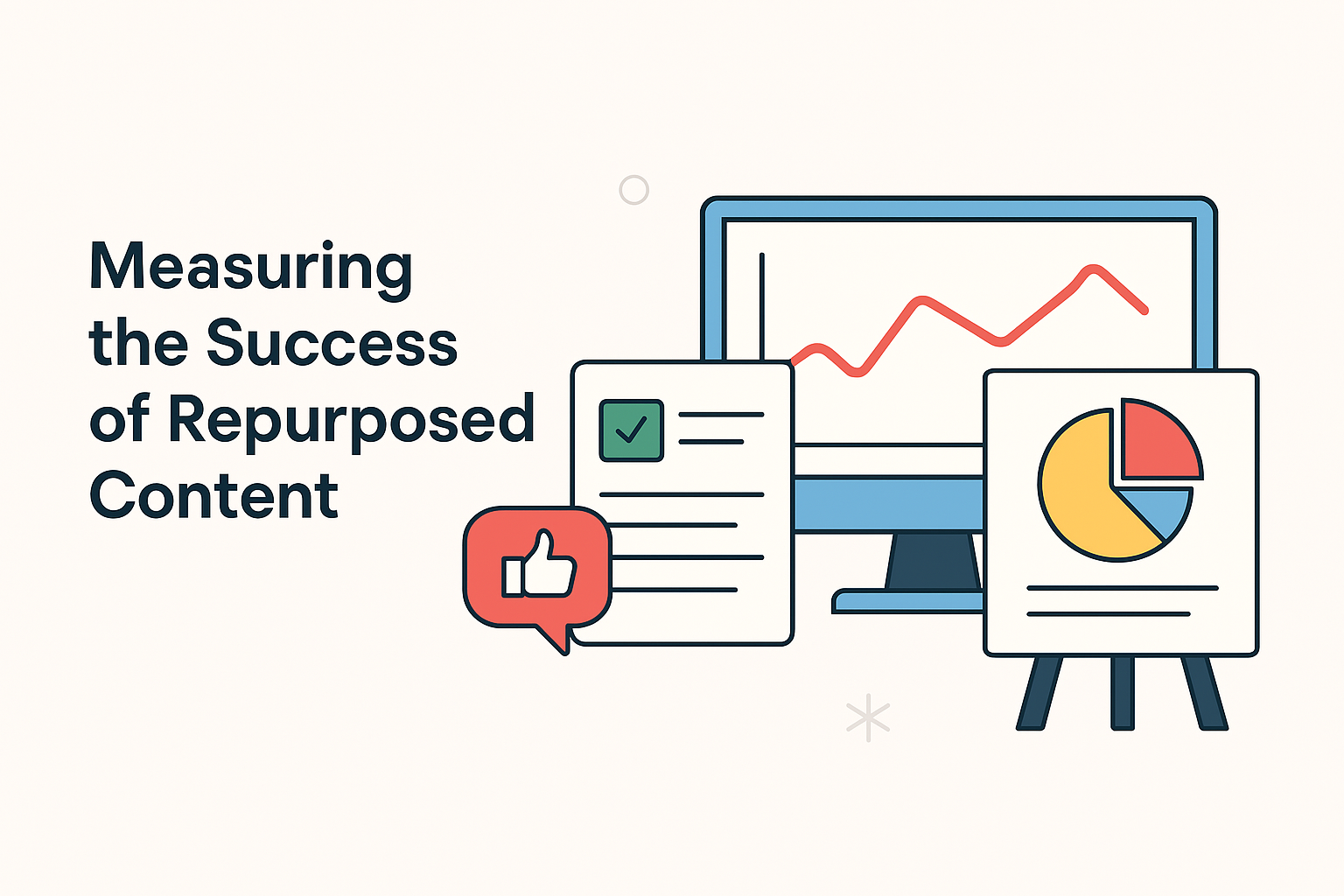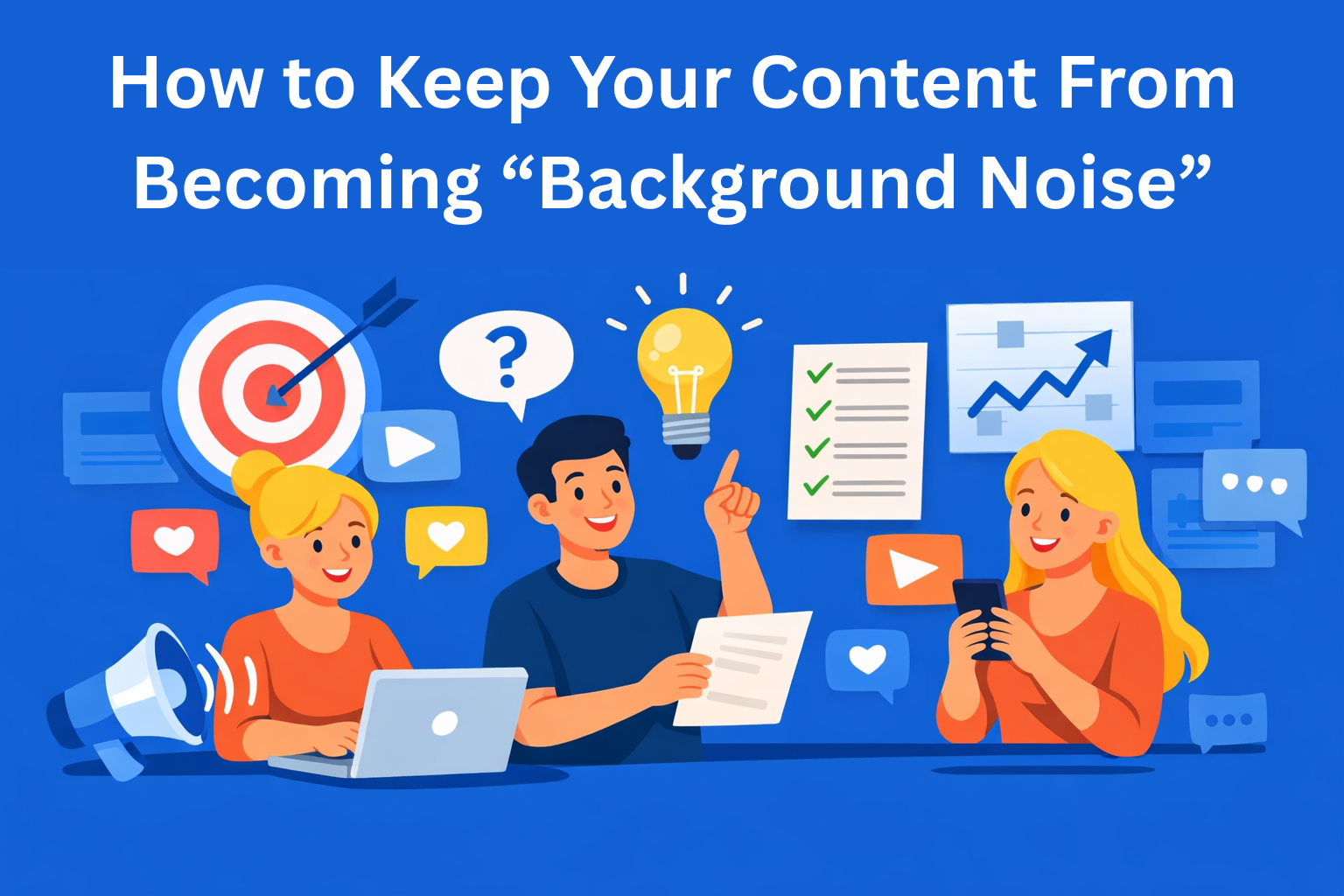Strategic Content Repurposing: How to Maximize Impact Without Creating from Scratch
Smart content repurposing saves time, boosts reach and engagement, and with tools like EasyContent, helps teams get the most out of existing material. Turn one piece into multiple formats and channels without constantly creating from scratch.

There is real pressure to make content.
Content teams today are constantly under pressure to offer original, high-quality content on a growing number of platforms. And let's be honest: making new content from scratch all the time is not only time-consuming, but it's also not always required.
The smart alternative is to reuse content.
This is where reusing content comes in. It's a smart, time-saving method that lets teams get more value out of the work they've already done without lowering the quality.
You don't have to start from scratch every time; you can give old things new life:
- A blog post that did well last year? Add new information to it.
- A long-form guide? Split it up into an interesting email series or short social media pieces.
- A live cast? You could make a highlight movie for YouTube or a blog post with all the important points.
More Reach with Less Work
Not only does reusing save time and money, it also expands the audience. Content is consumed in different ways by different people. Some people like to read, while others are more interested in images, short movies, or short posts on social media. Your message will reach the right people at the right time if you change it to fit different forms.
Keeping away from the chaos
But recycling can quickly become messy if you don't have a good method in place. You might come up with the same ideas more than once, get confused between different versions, or miss out on good chances. This is where sites like EasyContent come in handy.
EasyContent has built-in processes, approval jobs, and tools for teams to work together that help them:
- Plan and set up information in a clear way
- Repurposing should be managed well.
- Do not get lost in charts and files that are spread out.
What's Next for This Blog
Moving on, we'll talk about the following:
- The best recycling tools and methods to make your work easier
- How to adapt information in a way that has meaning and effect
- Ways to keep track of success and keep getting better
This guide will help you work smarter, not harder, and get the most out of the material you already have, whether you're in charge of a whole team of content creators or you work alone.
Key Takeaways
-
Repurposing content saves time and boosts efficiency
Creating everything from scratch isn't always necessary. Reusing content lets you extend its value without duplicating effort. -
One idea can fuel multiple formats and platforms
A single blog post can turn into social media carousels, email sequences, short videos, or infographics—maximizing reach across diverse audiences. -
Evergreen content is your secret weapon
Tutorials, case studies, and industry insights retain value over time and are ideal for repurposing again and again. -
Data-driven decisions guide successful repurposing
Use analytics to identify high-performing content worth reusing and transform underperforming material into more engaging formats. -
Tools like EasyContent make the process smooth
Organize, track, approve, and collaborate in one place. It helps teams stay aligned and ensures nothing falls through the cracks. -
Automation is key to scaling repurposing
Use tools like Buffer, Mailchimp, or EasyContent to automate publishing across platforms and save hours of manual effort. -
Track performance and iterate continuously
Monitor KPIs like engagement rate, SEO impact, and conversion data. Use A/B testing to refine your formats and messaging.
Why Repurposing Content is a Smart Strategy
Material production requires time, effort, and resources; let's be honest, it is not always possible to create new, from- scratch material consistently. Content reuse thus becomes really important. Smart content teams use already-existing material and give it fresh life across several media rather than rewriting the wheel. This is a calculated, deliberate method that optimizes effect in addition to saving time.
1. Saves Time and Resources
Imagine spending hours crafting a detailed, data-packed blog post, only for it to have a short lifespan before being buried under newer content. Use it rather than allowing it to gather digital trash. Convert turn-key insights into social media snippets, a podcast subject, or even an email newsletter. Content reuse lets teams optimize their efforts without double their work burden.
A marketing team working on an in-depth industry research for weeks, for instance, might divide it into several infographics, films, and blog entries. In addition to saving time, this guarantees consistent messaging throughout all media.
2. Increases reach over several platforms
Not every audience views material the same way. While some people enjoy reading long-form pieces, others interact more with videos, infographics, or bit-sized social updates. Reusing material guarantees that your message will be seen on several platforms by diverse kinds of people.
If you write a good blog article about content marketing trends, for example, you can:
- Turn it into a LinkedIn carousel to offer brief observations.
- Turn it into a YouTube video addressing important conclusions.
- Start an email series delving deeply into every trend.
Content teams may reach more people without recreating the wheel by using a disciplined reuse plan.
3. Reinforces Key Messages and Increases Engagement
Repetition is key in marketing. People rarely absorb a message the first time they see it. By repurposing content into different formats, you reinforce important messages and increase audience engagement.
Think about it—if a topic performs well as a blog post, chances are it will also do well as a Twitter thread, a short-form video, or an Instagram post. The more places your message appears, the more likely it is to stick with your audience.
4. Boosts SEO with High-Performing Content
Search engines love fresh content, but that doesn’t mean you always have to start from scratch. Instead of constantly writing new blogs, update and republish high-performing ones. Adding new insights, keywords, or relevant statistics can breathe new life into old content, making it more valuable for both users and search rankings.
By repurposing content, you also create more internal linking opportunities, which strengthens SEO and keeps users engaged longer. A single pillar post can be expanded into multiple supporting pieces, driving traffic across your entire site.
How EasyContent Helps with Content Repurposing
Keeping track of repurposed content can get messy without a structured system. This is where EasyContent comes in handy. It helps teams organize content, track what’s been repurposed, and manage approvals seamlessly. Instead of jumping between different tools, teams can plan, create, and distribute content—all in one place.
By using platforms like EasyContent, businesses can turn one great idea into multiple high-impact content pieces while ensuring consistency and efficiency.

Identifying the Right Content to Repurpose
Not everything is worth using again. While some works have long-term worth, others soon lose significance. Knowing what to recycle and what to retire from can help you to create strategic content. Analyzing prior performance, spotting evergreen subjects, and reworking underperforming material into better forms will help you avoid haphazard selection of outdated material.
1. Analyze Content Performance to Find Winners
The first step is to review past content performance to see what has worked well. Use analytics tools to track:
- Page views & traffic – Which blog posts or guides get the most visits?
- Engagement rates – Look at comments, shares, and time spent on a page.
- Backlinks – Content with many backlinks is considered valuable.
- Conversion data – Which pieces drive leads, sign-ups, or downloads?
A well-performing blog post from a year ago might still hold value, but it needs a refresh to stay relevant. By updating statistics, optimizing keywords, and repackaging insights, you can give it a second life across multiple channels.
2. Emphasize evergreen material for best impact.
Not every material remains valuable with time. While some subjects fade fast, others are important for years. Evergreen stuff is something which keeps worth long after it is first released.
Examples of evergreen content that’s great for repurposing:
✅ How-to guides – Tutorials that solve problems are always in demand.
✅ Case studies – Real-world success stories never get old.
✅ Industry insights and best practices: They may be updated and re-used as long as they are applicable.
✅ Long-form research & reports – Data-driven insights can be broken into multiple content formats.
For example, a detailed whitepaper on social media marketing trends can be repurposed into short LinkedIn posts, infographics, or even a podcast discussion.
3. Transform Underperforming Material into More Powerful Formats
Not every bit of material passes on the first run. While some blog entries offer excellent observations, they lacked popularity. Rather than giving up on them, try reorganizing the material into another format that readers will find more appealing.
For instance:
- A long, text-heavy blog post might work better as an engaging infographic.
- A low-performing webinar could be turned into bite-sized social media clips.
- An unnoticed case study might get more visibility as a slide deck for LinkedIn or a short-form video.
Sometimes, the content itself isn’t the problem—the format just doesn’t match how the audience prefers to consume information.
4. Apply data to direct decisions about repurposing.
Content should be driven by data rather than used haphazardly. Review your content collection often to identify what should be changed, enlarged upon, or transformed.
EasyContent and other platforms simplify content performance tracking, asset organization, and effort at reuse. Teams can see what's working and where improvements may be made all in one location instead of digging through dispersed information and antiquated spreadsheets.
Creative Ways to Repurpose Content
Making great material requires time and effort; why let it go to waste after only one use? Instead of always producing fresh material, smart content teams remake their best work across numerous platforms and media. Underlining key information helps to maximize reach and save time at the same time. Let us investigate some fresh ideas for optimum application of resources.
1. Turn Blog Posts into Social Media Snippets
A well-researched blog post can be broken down into bite-sized social media content that keeps your audience engaged. Instead of sharing just a link, try:
- Extracting important lessons and creating LinkedIn carouels out of them.
- Emphasizing smart quotations from the text, I would match them with striking images.
- Turning data points into Twitter or Instagram micro infographics.
If your blog post on content marketing trends, for instance, divide it up into a LinkedIn carousel with one trend per slide. One post so stimulates several conversations on several platforms.
2. Repurpose Webinars into Blog Posts, eBooks, or Short Videos
Hosting a successful webinar? Don’t just let the recording collect dust. Break it down into multiple content formats, such as:
✅ A blog post summarizing the key insights discussed in the session.
✅ An eBook or whitepaper that expands on the webinar topic.
✅ Short video clips (30-60 seconds) with the best moments for social media.
There is a lot of great material in webinars; repurposing it into searchable, shareable products helps distribute to individuals who missed the live event.
3. Transform Data-Heavy Reports into Bite-Sized Social Media Threads
Long reports and research papers can be overwhelming for most audiences. Instead of expecting people to read a 50-page PDF, break it into digestible pieces:
- Create a LinkedIn or Twitter thread summarizing the key stats and takeaways.
- Design an infographic that visually presents the findings.
- Record a short explainer video going over the most important insights.
For example, if a brand releases a "State of Digital Marketing 2025" report, they could turn each section into a separate LinkedIn post or a series of tweets—increasing visibility without extra effort.
4. Break Down Long-Form Content into Email Sequences
If you have a long blog post, guide, or case study, why not turn it into an email series?
Instead of sending one overwhelming email, break it into a multi-part sequence that:
📌 Introduces the topic in the first email.
📌 Shares one key takeaway per follow-up email.
📌 Ends with a strong call to action to engage readers further.
This keeps your audience engaged over multiple touchpoints, increasing the chances of conversions.
5. Refresh and Update Old Content for New Value
Review your top-notch old material and give it a fresh spin rather than always recreating the wheel. This might consist:
- Adding fresh research and examples to update past blog entries.
- Rewriting out-of-date case studies include current success stories.
- Including fresh graphics, videos, or professional quotations to improve current material.
By grouping materials on one platform, EasyContent simplifies this process and enables teams to rapidly locate and replace out-of-date items rather than starting from zero.
Automating and Streamlining the Repurposing Process
Although content repurposing is revolutionary for increasing reach and efficiency, without a structured approach it may quickly turn into a time-consuming nightmare. Oversaw many iterations, approvals, and distribution on several platforms might be draining. Here is where automated systems and simplified procedures enable content teams operate more wisely rather than more forcefully.
1. Using Automation to Schedule and Distribute Repurposed Content
Once content is repurposed, the last thing you want is to manually post it across multiple platforms every single time.Automation solutions help to control this so that your reused materials show up on the right channels and at the right timing.
To schedule items on social media, quickly republishing blog pieces, video clips, and infograms using Later, Hootsuite, or Buffer.
Teams may send outstanding messages with blog articles already created using Mailchimp or ConvertKit email marketing automation.
Artificial intelligence-driven recommendations transform now accessible materials for different target groups, hence enhancing engagement.
These techniques provide continuous distribution with least effort rather to hand copying and pasting content over several platforms.
2. How EasyContent Helps Teams Organize, Track, and Collaborate
Repurposing content at scale requires a centralized system where teams can track different versions, see what's been republished, and manage approvals—all without losing time in scattered email threads.
This is exactly where EasyContent comes in. It allows teams to:
✅ Store and arrange material on one platform so that it is simple to locate and rework outstanding sections.
✅ Assign tasks and track progress, ensuring everyone knows what needs to be updated or repackaged.
✅ Automate approval processes so material flows naturally from draft to final publishing without constant follow-up.
✅ Work together in real time to avoid misunderstandings and speed up the reuse process.
With EasyContent, content teams don’t have to start from scratch every time—they can quickly refresh, repurpose, and redistribute content with zero confusion.
3. Creating a Methodical Workstream for Reversal and Distribution
Strong content reuse policies rely on methodical approach. Content may disappear, be transferred at the incorrect moment, or be copied across numerous channels without a defined protocol.
A well-defined workflow should include:
📌 Identifying high-performing content worth repurposing.
📌 Summarizing the forms it will be converted into—blog → infographic, webinar → blog post, etc.).
📌 Assigning roles—who updates the content, who approves it, and who schedules distribution.
📌 Setting deadlines and using automation to ensure timely publishing.
Having a step-by-step repurposing plan eliminates guesswork and keeps teams aligned on what needs to be done.
4. Staying away from content duplication issues to get the most out of them
One of the biggest problems with reusing materials is that they can be published too many times with the same message or information that has already been shared without adding anything new.
These smart practices assist to reduce waste and boost speed:
Add fresh ideas, data, or case studies to previous work before it is once more released.
Change the message for every medium, from LinkedIn entries to Twitter discussions.
EasyContent and other repurposing technologies let you record prior rebranding initiatives and their distribution.
Teams can keep viewers interested, generate more traffic, and extend content life by carefully designing recycled materials—all without generating copies not needed.

Measuring the Success of Repurposed Content
Although repurposing material is a wise approach, how can one find out whether it is really working? Reusing material seems simple enough to boost interaction, but without measuring performance indicators, you might be just recycling content that isn't producing results. Measure success, evaluate performance, and then modify your approach to maximize your repurposing plan.
1. Key Performance Indicators (KPIs) to Track Effectiveness
Tracking the right KPIs will help you determine whether your repurposed content is making an impact or just taking up space. Here are some key metrics to watch:
- Engagement Rate: What response are people having to your revised work? See likes, shares, notes, and page time spent.
- Traffic Sources: Is the content you recycled driving to your website or landing page? Comparing organic, social, and referral traffic can help you to see where your information excels.
- Did the rewritten content generate purchases, leads, or sign-ups? If not, it might call extra effort.
- If you have changed and reared via previous blog articles, track ranks, keyword performance, backlinks, and SEO performance.
- Material Longevity: For what length of time is the recycled material relevant? Evergreen material should keep running strong over time.
Without well defined criteria, you are simply mindlessly reusing materials. Easy Content guarantees every recycled piece is successful by helping teams monitor and evaluate content performance.
2. Comparing Engagement Rates Between Original and Repurposed Content
One of the best ways to measure repurposing success is to compare engagement levels between the original and updated versions.
For example:
✅ You repurpose a high-performing blog post into an infographic and social media carousel.
✅ If the social posts get more engagement than the original blog, it means your audience prefers visual formats.
✅ If the blog post still drives more traffic, it suggests your audience prefers in-depth content.
A real-world example:
On its website, a firm included a long-form case study. Although the research attracted some reasonable traffic, participation was poor. Their 3x spike in engagement came from turning the material into bite-sized LinkedIn postings. Lesson discovered. Short, digestible insights appealed to the audience more than a protracted reading.
3. Refining Your Repurposing Strategy Based on Performance Insights
Not all repurposed content will be a home run, and that’s okay. The key is to use data to refine your approach.
Ask yourself:
📌 Which formats—written materials, infographics, or videos—did the best?
📌 Which channels drove the most traffic—LinkedIn, Twitter, or email?
📌 Did your audience engage more with new insights added to old content?
These findings will enable you to change your future repurposing scheme. If video material exceeds blogs, for example, focus more on turning works into brief explanatory movies.
4. The Role of A/B Testing in Improving Repurposed Content
Sometimes, even a small change can make a huge difference. A/B testing (or split testing) lets you compare different versions of your repurposed content to see what resonates most.
Example A/B tests for repurposed content:
🔹 Test two different email subject lines for a repurposed newsletter.
🔹 Compare a carousel vs. single image post on social media.
🔹 Experiment with two variations of a blog title to see which drives more clicks.
Content teams can examine data, control A/B testing, and organize efforts on improving content performance thanks to EasyContent and other technologies. Constant testing and improvement helps teams ensure that spent materials are not only recyclable but also most effective.
Don’t Create More—Create Better with Repurposing
Making great material takes time and effort; so, why let it go to waste after only one use? Not merely a shortcut, content recycling is a great approach to boost interaction, draw new audiences, and prolong the lifetime of your best work without constantly starting from scratch.
Why Reverse Reversing Change Everything?
One blog post, webinar, or research report might be converted into numerous pieces of information accessible on several platforms—social media snippets, infographics, short videos, email newsletters, and more. This ensures that in many contexts and formats your message gets the attention it deserves, therefore saving not just time.
Think about it:
🔹 That in-depth whitepaper can become a LinkedIn carousel or Twitter thread.
🔹 A popular webinar may be converted into short-form video clips for Instagram and TikHub.
🔹 An old blog piece can be modified with fresh ideas and re-published for SEO gains.
A Methodical Approach to Reusing
Simply copying and pasting material into several forms won't help you maximize the possibilities for reuse. Rather, use strategy:
✔ Find excellent material deserving of another life.
✔ Make it fit for several platforms; a serious blog article could have a laid-back attitude for social media.
✔ Automate scheduling and distribution to keep your workflow smooth.
How Simple Content Creates Repurposing Simplicity
Especially when juggling several platforms, formats, and deadlines, managing a repurposing strategy might seem daunting. EasyContent thus becomes quite helpful in this regard.
With EasyContent, teams can:
✅ Plan and arrange original material for simple access.
✅ Collaborate in real-time to refine repurposed materials.
✅ Automate approvals and workflows to keep projects moving.
✅ Track performance to see which repurposed content drives the best results.
Teams utilizing EasyContent can work smarter, not harder—getting the most value from the material they have already produced instead of rushing to produce something fresh every time.
The moment is here to start reusing!
Content repurposing is more about making your material work for you than about doing less work. Reusing and creatively changing already-existing material will maximize reach, interactivity, and return on investment without always running the wheel.
If you're ready to stop letting great materials go to waste, it's time to accept reuse. Look at sites like EasyContent to streamline processes, keep team structure, and ensure that every last bit of information has most impact.






